Block printing is a traditional textile art form that has its roots deep in history. Block print fabric originated centuries ago when artisans carved wood to create unique blocks that were used to create hand-printed textiles. From floral motifs to geometric designs today, Rajasthani block print has come a long way. In this blog, let’s delve deeper into what is block printing, the history of textile printing in India and how ethnic block printed fabric has become a fashion trend in the country today.
Meaning of Block Printing
Block printing refers to the use of hand-cut wooden blocks for printing purposes. Special types of block printing are done on cloth or paper to augment the ethnic appeal of what’s being made. Artisans use wooden blocks to print attractive patterns on cloth. The artistic appeal of doing this by hand is unmatched and hand block print fabric is one of the most sought-after textiles in the world for its traditional appeal.
It is a traditional and ancient art form in which printing is done on paper, fabric and some other materials with the help of natural colours and vegetable dyes. In many places, Block Printing is as popular as Woodblock Printing, Hand Block Printing, Or Woodcut Printing. The process involves carving the required designs on blocks and using natural colours and dyes to print them on different fabrics.
Origin of Block Printing
When we talk about the history of block printing, it is said to have originated in China and subsequently, it became extremely popular across the world; widely being practised in East Asia. (1)
Interestingly, the earliest record of block printing isn’t on cloth, but on a book known as Diamond Sutra. (2)
The book is kept for display at the British Museum in London. Block printing made major inroads in India during the Mughal period and over the years, the Indian ethnic block printed fabric has become an endearing textile choice for people across the globe.
Block Printing in Rajasthan
The northwestern state of Rajasthan is a land steeped in history, culture and arts. Rajasthani block print tradition has flourished over centuries and today Jaipur block print fabric has built its own legacy.
In the 12th century, The Chippa community of the Bagru area of Rajasthan introduced this unique craft. Motifs were carved into wooden blocks skillfully using chisels and other tools and these blocks were used to make prints on fabric using vegetable dyes.
The skills of wooden block printing has been passed through generations among artisans communities making Rajasthani block print immensely popular. Places like Jaipur, Bagru, Sanganer, Barmer, and Sikar have emerged to be the hubs of ethnic block printed fabrics in Rajasthan with their own uniqueness.
With the high presence of block print fabric suppliers in Rajasthan, many of these block printing techniques have earned Geographical Indication (GI) Tags in India. Sanganeri hand block printing received a GI tag in 2009 while Bagru Hand block printing received it in 2011.
Types Block Printing
iTokri is an online portal that has aggregated traditional art forms and one such exhibition on the website is a bespoke range of different kinds of Indian block print.
Ajrakh Block Printing
Ajrak is one of the most famous types of block printing. Ajrakh block printing relies on the use of natural vegetable dyes. It is characterised by crimson red and indigo hues as the background on the printed cloth. This form of block printing is very prevalent in Gujarat, Kutch, Rajasthan and Sindh, Pakistan
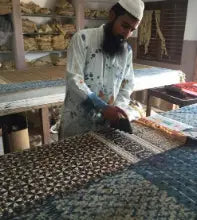
Akola Block Printing
This kind of block printing is widely practised in the Udaipur region of Rajasthan. This traditional art form relies mainly on the ‘Dabu’ art which means ‘to press’. The patterns used for Akola block printing are inspired by nature and other traditional objects.
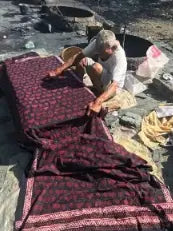
Bagh Block Printing
Bagh is a traditional Indian block print that originated in the Bagh district of Madhya Pradesh. The colours used for dyeing this hand block print fabric are all natural colours and they pivot mainly around. Red and black. The Bagh block print cotton-dyed dupatta from iTokri can be a great addition to your wardrobe if you are looking for something ethnic to amplify the appeal of your outfits.

Bagru Block Printing
Bagru block printing is a special kind of block-printed fabric that is done using a ‘Chippa’ and natural colours. The design is engraved on the wooden block and then engraved on the fabric. (6) The Bagru block printing cotton men's full sleeves shirts on iTokri is a super smart and traditional men’s shirt that can spruce up your wardrobe in no time. Bagru block print fabric suppliers are one of the oldest in India.
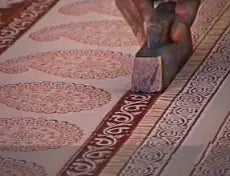
Batik Block Printing
Batik block printing originated in Indonesia and it entails printing a design on cotton fabric using wooden blocks dipped in paraffin wax. It is a cumbersome task because the wax is resistant to dyes and it has to be removed in order to allow the artisan to add colour to the cloth.
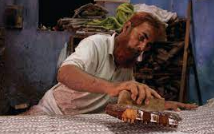
Kalamkari Block Printing
Kalamkari is a special hand-painted textile that is produced in the Indian state of Andhra Pradesh. There are twenty-three steps involved in the making of this special Indian block print fabric and there are two types of Kalamkari fabric known as Srikalahasti and Machilipatnam.
The Pedana Kalamkari Block Printing Cotton Double Bed Cover from iTokri can add oodles of charm to your home decor.

Kutch Block Printing
Kutch black printed fabric usually involves printing a similar design on fabric using different techniques including the famous Ajrakhi prints. This special block printing technique originated in Kutch nearly four hundred years ago and it has amassed a huge fan following ever since.
Pipad Block Printing
This Pipad block printing involves the use of wooden blocks for printing with nails protruding from them. Various kinds of floral, traditional and geometrical designs are printed with natural dyes using this technique.
Sanganeri Block Printing
This type of hand block printing technique is practised in the Sanganeri district of Rajasthan. Primarily, red and yellow colours are used for this kind of block printing and the motifs/designs are usually inspired by nature. Moreover, the dyes used in Sanganeri block printing are natural dyes.
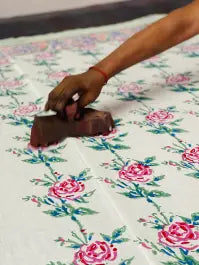
Tools & Techniques of Block Printing
We have included a list of tools and techniques that are used in various types of dyeing techniques in India :Ajrak
Ajrak print denotes the local culture and heritage. The wooden blocks are used to create geometric designs and only natural or vegetable dyes are used in this process.
Bagh
For Bagh's painting, geometric designs are made with bright colours. For this printing process, the fabric undergoes a ‘Bhatti process’ that entails boiling, drying and subsequent printing.
Kalamkari
For Kalamkari, the fabric is stiffened and dried. After that, different prints are carried out as per the design. Wax is used for dyeing blue colour whereas all other colours are hand-painted.
Dabu
This form of printing is a rather cumbersome process and the fabric is made to go through various phases of washing, printing, mud resistance and then drying.
Bandhani
For Bandhani, the fabric is plucked using fingernails. These bindings are then dyed. Bandhani fabrics are brightly coloured and they are characterised by little dots on the fabric.
Block printing since ancient times involves meticulous techniques and requires skilled artisans. Let us share some of the traditional techniques that are used in Rajasthani block printing.
Block Carving
The first step of this craft is to create the block. Wooden blocks are carved with chisels with intricate designs often inspired by nature like floral designs, leaves, animals and more. You can also find geometric designs and motifs inspired by mythology.
Dyeing
Traditionally, only natural dyes were used in Indian block printing. These natural dyes were extracted from flowers, vegetables, minerals or insects. Some of the commonly used vegetables and plants for natural dyes are turmeric, indigo, madder root and more.
Printing
The carved wooden blocks are dipped into the dye and pressed onto the fabric to create unique designs. Sometimes multiple blocks are used for complex designs and multi-colour.
Modern techniques in block printing include resist printing and screen printing making the process faster.
Conclusion
India enjoys cultural affluence and therefore our traditional art forms and handicrafts are a name to reckon with in the global market. The famous Indian block print is one of the most popular and age-old art forms that pays tribute to the impeccable skill of the artisans who have perfected their respective craft over generations. With the largest number of block print fabric suppliers, Rajasthan is a state to reckon with for block printing craft. Today Jaipur block print fabric has translated to being more than fashion with artisans adapting to modern trends while preserving traditional techniques.
FAQ:
Does woodblock printing history originate from the Chippa community in Rajasthan who brought and propagated this special hand block printing technique in India including Bagru hand block print, Sanganeri block print etc.
Indian block printing method uses carved wooden blocks and vegetable dyes to create beautiful motifs and designs on fabric. They are used to create clothing, home furnishing and more.
Block printing is said to have originated in China and the first known administration of this type of printing was not on cloth, but on a book known as Diamond Sutra.
Block printing origin dates back to 220 AD China.
Block printing originated from the Chippa community in a place known as Bagru in Rajasthan.
There are three main types of block printing in India: direct printing, discharge printing and resist printing.
Sheesham wood is used for Indian block printing. Each block in every colour is used to put together a beautiful and concise design.
Saffron, yellow, blue and red is mainly used for block printing. This form of printing is used to create rich and colourful prints.
Blogs you might also like:
Indian Dupattas Of The Late 1990s That Are Still Popular
Stunning “Phad” Art from Rajasthan
Sarasa—The Gujarati kalamkari cloth that became a rage in Japan
 Verified Purchase
Verified Purchase
















































Fabritual Fabric
Liquid error (sections/custom_blog_posts line 652): The format option 'month_day_year' is not a supported format.
“Transform your space with these exquisite linen fabric cotton curtains! Elevate your home’s aesthetic with the perfect blend of luxury and comfort. The natural textures of linen and the timeless appeal of cotton come together to create a stylish and inviting atmosphere. Embrace quality and sophistication in every thread – make a statement with our premium curtains for a truly elegant living experience!”